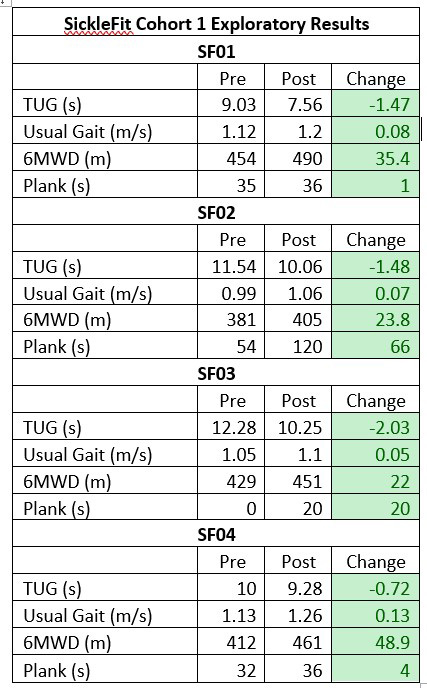Background
Older adults with sickle cell disease (SCD) (defined as age ≥ 40 years) experience both SCD and age-related conditions such as recurrent pain episodes, avascular necrosis of the joints, and cardiopulmonary disease that can result in accelerated functional decline. Individuals with SCD experience vaso-occlusive events that lead to reduced oxygen delivery to organs such as bones, muscles, and lungs. Due to these unique risk factors, existing generic exercise programs may be too intense– and even detrimental– for older adults with SCD. Gerofit is a supervised exercise program designed for veterans age ≥ 65 years with chronic disease and/or impaired mobility that has been shown to improve physical function, mental health, quality of life, and survival. The purpose of the study is a pilot evaluation of the feasibility and safety of SickleFit, an exercise training program for older adults with SCD adapted from Gerofit.
Methods
SickleFit is a group exercise program held on Zoom 3 days a week and includes a safety check in, warm-up, cardio segment, strength training, flexibility, balance, and mindfulness. Our primary endpoint is feasibility measured by proportion of participants attending at least 50% of the sessions over 6 weeks. The secondary outcomes are safety and acceptability. We measured safety as the number of moderate or severe adverse events within 48 hours after each exercise session. Acceptability was measured as the proportion of participants reporting the intervention as satisfactory. Exploratory outcomes were changes in physical performance in a battery of physical assessments including: Usual Gait Speed, 6 Minute Walk Distance (6MWD), Plank duration, Timed Up-and-go (TUG), Seated Grip Strength, Weight, and Neck Circumference.
Results
Cohort 1 consisted of 2 male (aged 55 and 66 both with SS genotype) and 2 female participants (aged 43 and 53 with Beta + Thalassemia and SS genotype). All 4 participants met the feasibility endpoint of attending at least 50% of exercise sessions, with a mean attendance of 83%. The majority of absences were due to schedule conflicts (2), property maintenance (2), and general malaise (4). Over a third of the missed sessions were due to minor (2) or major (3) adverse events unrelated to the intervention (motor vehicle incident, work-related injury). There were no major or life-threatening adverse events as a result of the exercise intervention. Minor adverse events related to exercise were knee, shoulder, and back soreness and pain.
All participants responded as either ‘Pleased’ (50%) or ‘Delighted’ (50%) with the program on the acceptability survey. In addition, all participants saw a positive increase in their performance of the Usual Gait Speed, TUG, 6MWD, and plank duration. Minor improvement in grip strength was seen in 3 participants, but a slight loss in grip strength occurred in one individual whom also lost the most weight. While no significant change occurred in the BMI of the participants, a reduction in neck circumference did occur.
Conclusion
In cohort 1, we found that the SickleFit exercise program is feasible, acceptable, and safe for older adults with SCD. Participants demonstrated improvements in Usual Gait Speed, TUG, 6MWD, and plank duration, among other physical metrics. Participants expressed satisfaction in the program and a desire to continue in the program, even after the program ended. Based on patient feedback, The Sicklefit program is being optimized further to better meet the needs of older adults with SCD. Optimizations include shortening of the cardio section for the initial weeks of the program, dedicating more time to discussing the biomechanics and form involved in the exercises, integration of more ground-based and vertical pulling patterns with resistance bands, and adding further diversity in the movement practices included in the sessions.
Disclosures
Strouse:Agios, Takeda, Disc Medicine: Consultancy, Research Funding.


This feature is available to Subscribers Only
Sign In or Create an Account Close Modal